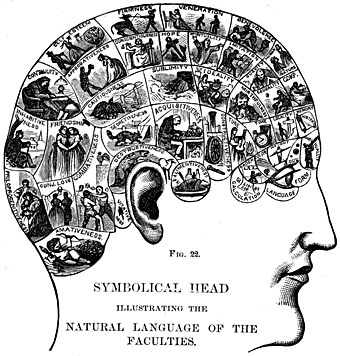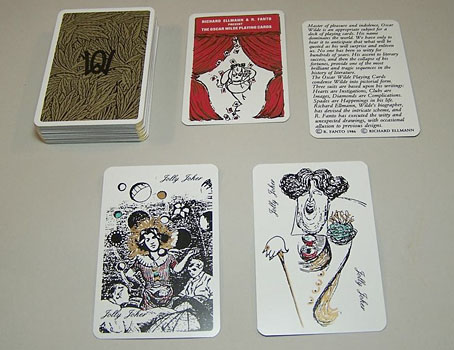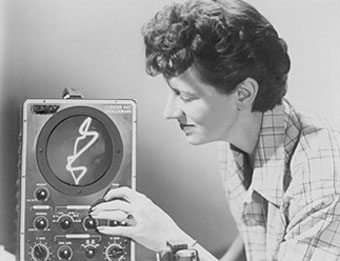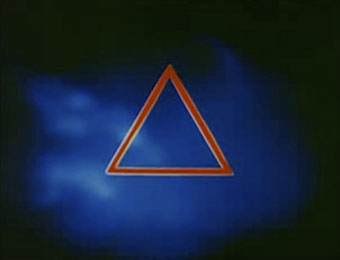Down and out in Paris | Jeanette Winterson revisits Shakespeare and Company.
Tag: James Joyce
Patrick McGoohan and The Prisoner
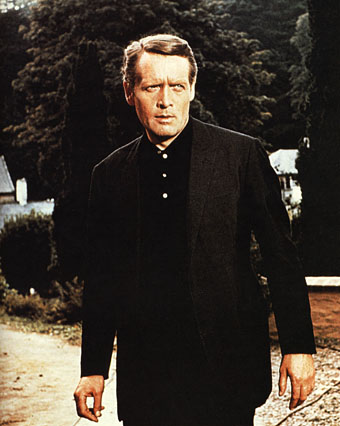
Patrick McGoohan as The Prisoner.
“I will not be pushed, filed, stamped, indexed, briefed, debriefed or numbered. My life is my own.”
The Prisoner, which ran for seventeen episodes from 1967 to 1968, was the best original drama series there’s ever been on television. Period, as Harlan Ellison would say. Best because it grabbed the format of the TV adventure series with both hands to subvert the expectations of the audience and the people who were paying for it. Best because it dared to do this at a time when there was little precedent for experiment in a medium that was barely a decade old. Best because it had something important to say while still being entertaining. And best because it had Patrick McGoohan in the central role at the peak of his acting career.
Fiction can be anything, but to look at what we’re offered by TV channels you wouldn’t know it. Cop shows, hospital shows, detective shows and soap operas proliferate, ad infinitum. The Prisoner came out of Danger Man, an immensely successful post-James Bond spy series which may have been popular but, McGoohan’s presence aside, has little to recommend it today. It lacked the camp bravura of The Avengers and couldn’t compete with the budgets of the Bond films. But it’s fair to say that without it McGoohan wouldn’t have had the chance to do something radical. ITC’s Lew Grade thought he was getting Danger Man 2 with better production values; what he received—to his eventual dismay—was the kind of television one would expect if the staff of Michael Moorcock’s speculative-fiction magazine New Worlds had been given a fat budget and free reign. Like New Worlds, The Prisoner seized familiar genre themes but took them as a means to an end, not an end in themselves. The series borrowed from science fiction and spy thrillers—brainwashing and mind control, Cold War paranoia, the limitless surveillance and duplicity of Orwell’s Nineteen Eighty-Four—and used a drama format to say something direct and personal to its audience about individual freedom, the limits and excesses of the state, and the importance of being able to say “No” when the world insists that you capitulate.
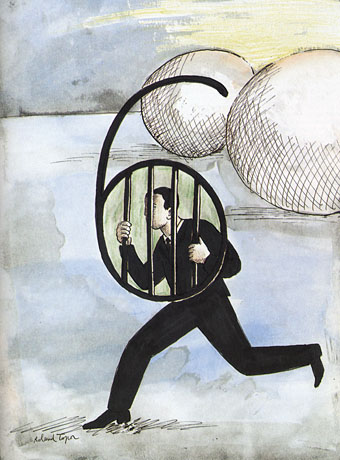
Number Six by Roland Topor.
McGoohan was the driving force as well as the star. His own company, Everyman Films, produced the series for ITC; he planned everything with the writers, wrote three episodes and directed five of them himself. The Prisoner only lasted for a season and a half—cut short after Grade lost his patience—but the form was potentially endless, flexible enough to present a familiar Cold War spy story on the one hand, while having an entire episode play as a Western, on the other. In one of the later episodes McGoohan is largely absent when his mind is transferred to another man’s body and he finds himself living a new life, ostensibly a free man. (But freedom in The Prisoner is always circumscribed.) The last three episodes collapse everything that’s preceded them into intense and increasingly surreal psychodrama. Like Moorcock’s fluid character Jerry Cornelius, whose exploits were running in New Worlds while The Prisoner was being broadcast, McGoohan had found a vehicle to say what he wanted about the world using popular culture. It’s a coincidence but I’ve always found it apt that the cover illustration for Moorcock’s novella The Deep Fix (1966) included a figure obviously modelled on McGoohan’s Danger Man. The book’s tagline “Drugs took him into a nightmare world where logic ceased to exist” could be a description of a later Prisoner episode. Apt too that the first novel based on the series in 1969 was by New Worlds regular Thomas M Disch.
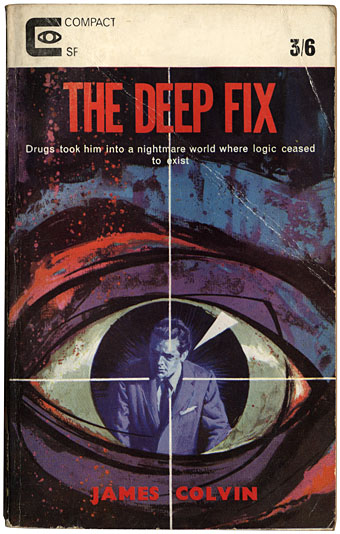
(James Colvin was a Moorcock nom-de-plume.)
The Prisoner was produced in the era of the social dramas of The Wednesday Play and Play for Today yet it remains relevant in a way its worthier contemporaries could scarcely manage. Social realism dates as quickly as yesterday’s news but allegory stays fresh. And it’s a dismal truth that the world of infinite surveillance has crept closer in a way that few would have imagined possible in 1968. The cameras that follow McGoohan’s Number Six everywhere are a familiar sight on Britain’s streets; a headline in yesterday’s Independent newspaper read: “Big Brother database a ‘terrifying’ assault on traditional freedoms“. McGoohan, who was raised in Ireland, would have appreciated the adherence of another Irishman, James Joyce, to the Luciferian cry of disobedience in Ulysses, “Non serviam!”—”I will not serve”. Joyce’s Stephen Dedalus defies God and his family; McGoohan’s Number Six defies everything else. That example, of the man who can “make putting on his dressing gown appear as an act of defiance”, is something we need as much now as we did in 1968. Hollywood is currently threatening a big-screen version but why wait for more compromised studio product when you can go to the source. Get yourself a deep fix—it’s a masterpiece.
Previously on { feuilleton }
• Thomas M Disch, 1940–2008
• Revenant volumes: Bob Haberfield, New Worlds and others
Psoakoonaloose me
— You’re a nice third degree witness, faith! But this is no laughing matter. Do you think we are tonedeafs in our noses to boot? Can you not distinguish the sense, prain, from the sound, bray? You have homosexual catheis of empathy between narcissism of the expert and steatopygic invertedness. Get yourself psychoanolised!
— O, begor, I want no expert nursis symaphy from yours broons quadroons and I can psoakoonaloose myself any time I want (the fog follow you all!) without your interferences or any other pigeonstealer.James Joyce, Finnegans Wake
More from the world of the web meme. Current favourites doing the rounds include various blog analysers which are by no means scientific but which curiosity impels one to try out anyway. The Typealyzer subjects your words to a Myers-Briggs Type personality test which in my case reveals me to be in the INTP class:
The Thinkers
The logical and analytical type. They are especialy (sic) attuned to difficult creative and intellectual challenges and always look for something more complex to dig into. They are great at finding subtle connections between things and imagine far-reaching implications.They enjoy working with complex things using a lot of concepts and imaginative models of reality. Since they are not very good at seeing and understanding the needs of other people, they might come across as arrogant, impatient and insensitive to people that need some time to understand what they are talking about.
I’ve never tried a proper Meyers-Briggs test but the above seems quite accurate if anything so vaguely algorithmic can ever be thus described. I did try an Enneagram test a while ago and came out as a Four (The Individualist) which is more applicable than the others on that scale.
Back at the web testing, the GenderAnalyzer rates { feuilleton } as 99% male based on the aforementioned “logical and analytical” writing style. So much for gay men being more feminine… I can’t help but feel slightly disappointed by this. I obviously need to get in touch with my inner drag queen, in which case the Drag Queen Name Generator would be a place to start.
Previously on { feuilleton }
• The CD cover meme
• Another lazy meme post
Oscar Wilde playing cards
A set of playing cards created in 1986 by artist Rosita Fanto in association with Wilde biographer Richard Ellmann. Out of print now as these things usually are but this card trading site has more views of the cards, as does this page. Fanto and Ellmann also created a card set based on James Joyce’s life and work.
The Oscar Wilde Playing Cards condense Wilde into pictorial form. Three suits are based upon his writings: Hearts are Instigations, Clubs are Images, Diamonds are Complications. Spades are Happenings in his life. Richard Ellman, Wilde’s biographer, has devised the intricate scheme, and R. Fanto has executed the witty and unexpected drawings, with occasional allusion to previous designs.
Update: Neil Bartlett reviews Oscar’s Books by Thomas Wright.
Elsewhere on { feuilleton }
• The Oscar Wilde archive
Mary Ellen Bute: Films 1934–1957
Mary Ellen Bute.
Last week I noted the appearance at Ubuweb of Mary Ellen Bute’s little-seen Passages from James Joyce’s Finnegans Wake. News comes this week of an exhibition of her abstract films at sketch, London.
sketch presents the first gallery survey exhibition of abstract film by Mary Ellen Bute (b. Houston, Texas 1906, d. 1983).
From 1934–1957 Mary Ellen Bute made fourteen short films pioneering techniques with light, sound and the moving image. Her work involved collaborating with artists, musicians, inventors and others who adopted a scientific experimental approach to creating sound and optical effects. In addition to sampling hand processes such as drawing and painting directly on film the work features imagery created automatically by a custom-built, cathode-ray oscilloscope. She can one of the first woman artists to experiment with the medium but unlike contemporaries Hans Richter (b. 1888), Len Lye (b. 1901) and Oskar Fischinger (b. 1900) her work remains largely unknown. This exhibition brings together a complete chronology of her abstract films, most of which have never been shown in Britain and for the first time will present her work as a multi-screen installation using sketch’s twelve projectors. This exhibition has been curated by Michelle Cotton who has included Bute’s work in survey of artist film distributed by the Independent Cinema Office. Essentials: Modernity will be released nationwide later this year.
A publication featuring essays and previously unpublished material will be published by ALMANAC to be launched in September 2008. ALMANAC is curatorial studio and independent imprint run by Andres Bonacina, Victoria Brooks, James Lambert & Anne Low.
The exhibition runs from 26 July to 13 September, 2008.
Synchromy No. 4: Escape.
For those of us not in London, there’s always YouTube which has a small selection of Ms Bute’s work and in decent quality for once. The two later colour films are especially worth watching; Tarantella was a collaboration with Norman McLaren while Synchromy No. 4 used Bach’s Toccata and Fugue in D Minor two years before Disney’s similar sequence in Fantasia.
Mary Ellen Bute on YouTube:
• Rhythm in Light (1934)
• Dada (1936)
• Synchromy No. 4: Escape (1938)
• Tarantella (1940)
Elsewhere on { feuilleton }
• The abstract cinema archive

